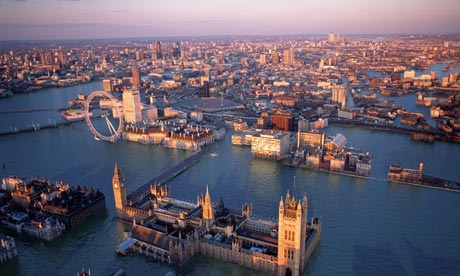- The Guardian,
- Article history

Flash floods will drown London and Yorkshire, a major reservoir will blow out in Derbyshire, rivers will burst their banks from the Thames valley to Wales and a tidal surge will swamp the east coast in the armageddon scenario underpinning Britain's biggest ever civil emergency exercise.
Exercise Watermark will involve 10,000 people from the police to prison officers and equipment from helicopters to hospitals, testing the nation's ability to respond to a range of major flood emergencies. At its heart is a plasma screen-decked control room in Fareham, Hampshire, from where Environment Agency planners will reveal the simulated disasters to responders across England and Wales, with each major event getting its own day.
Local emergency services, councils and community groups will be the first to react, before escalating the response through hospitals, water and energy companies and the armed forces all the way up to ministers and a meeting of the government's top crisis response committee, Cobra. The "players" in the exercise, including environment minister Richard Benyon, will have no advance details of the emergencies and will react in real time.
"This is a really major event," said Benyon. "Regrettably, one thing is certain, especially with the influence of climate change: there will be more floods in future. The exercise provides a unique opportunity for us to test our responses."
The Environment Agency chairman, Lord (Chris) Smith, said: "One in six properties in England and Wales is at risk from flooding. Exercise Watermark will help protect lives and homes against future floods." He said it was very unlikely the four emergencies would all happen in the same week, but an EA spokesman added: "We have seen big events of all these types at separate times in recent years."
"Every one of those is a realistic scenario, absolutely," said Charles Tucker, chair of the National Flood Forum, which represents more than 200 community groups. "Hundreds of communities have been flooded over the last decade and hundreds more will be flooded in the next decade: it is the nightmare waiting to come to a street near you." That, he said, is why the exercise and its focus on protecting people from harm is valuable.
The exercise will cost £1.8m but follows year-on-year government cuts of £144m in flood defence spending.
Several live rescues will take place, with RAF helicopters lifting stranded passengers from the roofs of stranded buses at Lake Bala in Gwynedd and boats rescuing people from submerged cars and caravans at Tattershall country park, Lincolnshire. Instant flood defences will be built and schools and care homes evacuated as part of the exercise.
"We will not get everything right in Exercise Watermark, but the point is to learn from the mistakes," said Benyon. The planners will be able to change the storyline as events unfold to test responses fully. "Floods can happen at any time," said David Rooke, the EA's director of flood and coastal risk management. "I have been in Cobra meetings chaired by the prime minister at 6 in the morning and 11 at night."
The previous biggest civil emergency exercise was called Winter Willow and tested the national response in 2007 to a bird flu epidemic. Previous exercises, such as Atlantic Blue in 2005, tested the response to terrorism attacks.
A full-scale national emergency exercise was one of the key recommendations of the Pitt Review, which analysed what went wrong during the devastating floods of 2007.
While the exercise has been broadly welcomed by those concerned with flooding, there is concern that the significant cuts to flood defence spending, at a time when risk is rising owing to climate change, will mean fewer people gaining flood protection. "Obviously, putting up new flood defences is essential and it will be a struggle to find the funding in the next 10 years," said Tucker.
Last month, the Guardian revealed that the government's cuts had slashed the number of flood defence projects in line for funding in 2011-12 from 630 to 356, including major projects in Leeds, York and Morpeth. In total, more than 1,000 projects that had been in line for funding by 2015 now have no projected budget.
Mary Creagh, Labour's shadow environment secretary, said: "Around 5.2m homes are at risk from floods in the UK so it is vital that our public services plan for and practise large-scale emergencies. Yet the Tory-led government cannot escape from the reckless gamble they have taken by cutting the flood defence budget by 27% over the next four years. Major flood defence projects have been cancelled, and people are worried about the availability of flood insurance when Labour's deal with the insurance industry runs out in 2013."
Benyon said: "We have protected flood defence spending way in excess of other areas of spending across government. There will always be more we would like to do."